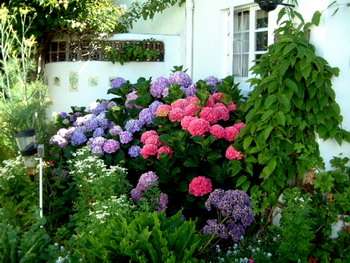We’ve been learning about pH and the environment of the body. So this excerpt from some of our teaching on pH continuing our discussion on hydrangeas and is also a sneak peak leak inside our Bootcamp teaching and conversations with our teams:
 Just exactly like garden soil, which also has pH, the environment of the body dictates what grows… in this case, sickness or health. And, much like checking chemicals in a pool or spa, the pH of certain fluids of the body can be measured. It is important to note that pH measurement is not diagnostic, but rather indicates environment, which suggests strongly the potential for growth of one thing over another.
Just exactly like garden soil, which also has pH, the environment of the body dictates what grows… in this case, sickness or health. And, much like checking chemicals in a pool or spa, the pH of certain fluids of the body can be measured. It is important to note that pH measurement is not diagnostic, but rather indicates environment, which suggests strongly the potential for growth of one thing over another.
Let’s make this easy to see. The hydrangea plant is the world’s best teaching illustration for soil environment and pH.
“Hydrangeas are fascinating in that, unlike most other plants, the color of their flowers can change dramatically. …hydrangeas often change color on their own when they are planted or transplanted. They are adjusting to the new environment. It is not unusual to see several different colors on one shrub the next year after planting.”
Pink blooms result from an absence of aluminum in the soil and a alkaline soil pH. To encouragement pink blooms, one can “add dolomitic lime several times a year. This will help to raise the pH. Shoot for a pH of about 6.0 to 6.2 (If it goes above 6.4 hydrangeas may experience an iron deficiency). Since hydrangeas take up aluminum best at lower pH levels, raising the pH will help to keep the bluing effect of aluminum out of the hydrangea’s system.”
Blue blooms result from the uptake of aluminum in the soil and an acid soil pH. To encourage blue blooms, one would “make aluminum available to the plant, the pH of the soil should be low (5.2-5.5). Adding aluminum sulfate will tend to lower the pH of the soil. Another method for lowering the pH is to add organic matter to the soil such as coffee grounds, fruit and vegetable peels, grass clippings etc.”
“If the soil naturally contains aluminum and is acid (low pH) the color of the hydrangea will automatically tend toward shades of blue and/or purple.
The choice of fertilizer will also affect the color change. A fertilizer low in phosphorus and high in potassium is helpful in producing a good blue color (25/5/30 is good. Potassium is the last number). Superphosphates and bone meal should be avoided when trying to produce blue.
After stating this with much certainty, I hasten to add that it is virtually impossible to turn a hydrangea blue for any length of time if it is planted in soil with no aluminum and that is highly alkaline (chalky). One would have to be very diligent in keeping the soil properly conditioned as stated above.
One last suggestion for those who are serious about this process: It is important to have your water tested so that it will not “contaminate” the soil that you have so rigorously balanced. The pH of the water should not be higher than 5.6.
Planting hydrangeas near a concrete foundation or sidewalk will often affect the color since the pH of the soil may be raised considerably by lime leaching out of these structures…”
“It is much easier to change a hydrangea from pink to blue than it is from blue to pink.”
(Selah – stop and think on that.)
“Changing a hydrangea from pink to blue entails adding aluminum to the soil. Changing from blue to pink means subtracting aluminum from the soil or taking it out of reach of the hydrangea.” *
You see, to translate that into the soil of our bodies, pink is good, blue is bad. Imagine that. Fearfully wonderfully made. Blue is high aluminum and low oxygen. Same in the body. WOW. Is that a great visual or what?
The lesson on hydrangeas is this: learn how to change the environment of the dirt, the land, and you change what is produced or what can grow there. Cancer, for instance, grows in an anaerobic (without oxygen) environment, the state reflected by an acid pH -just like the blue flowers. As you make changes in the environment year to year, the resulting “crop” changes too.
Please pause just a minute to watch the picture below:
What kind of crop do you desire? What kind of soil are your choices providing? How much fertilizer did you use when you answered those two questions? {smile}
While the methods to change the soil of our body will vary slightly from the farmer’s – although only slightly – the concept is exactly the same. There are many rich keys to health in the story of our hydrangeas today, much to meditate on. I’ll see you over on our Facebook and Twitter feeds for questions! Remember Fridays are always Free-reign Fridays where we welcome questions and I even pass some along to Dr. Ray Pearson for his wisdom and expertise to answer – so get involved on the page conversation! #livefully #beinformed
Thanks to http://www.hydrangeashydrangeas.com/colorchange.html for the quoted material on hydrangea pH.
- Great Faith Adventures - August 15, 2020
- Great Faith Adventures – Video Gallery - March 10, 2018
- 2016 Annual Year End Ministry Report - February 4, 2017


